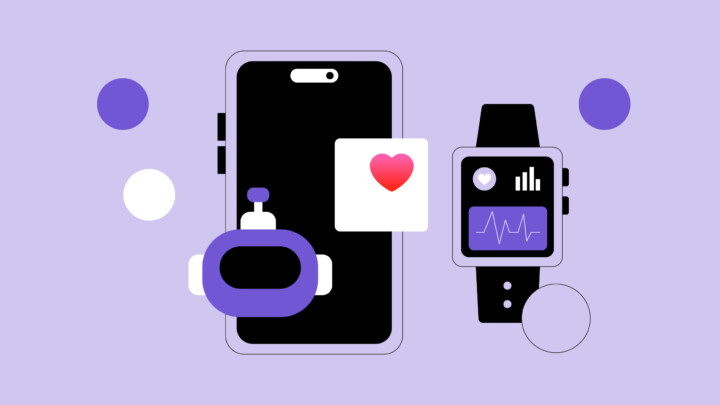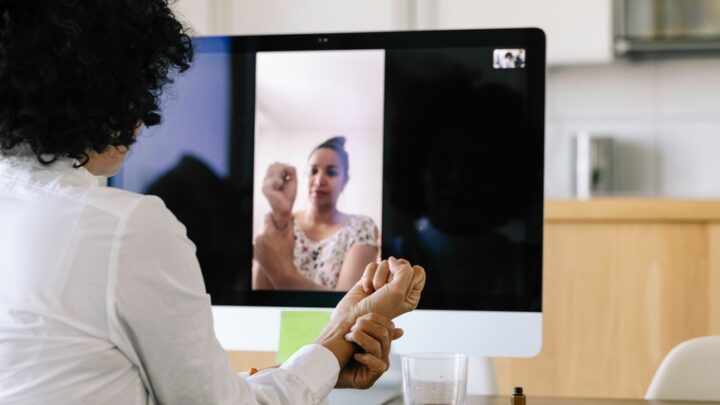
Since the COVID-19 pandemic, telemedicine healthcare has grown substantially and now remains an integral part of the healthcare system. It has been well-received by many physicians, who are sharing their experiences on Sermo, and transforming lives by offering flexibility and improved outcomes.
Telemedicine expands healthcare access, contributing to increased patient satisfaction and improved quality of care. Overall, telemedicine and remote work are continuing to transform healthcare, providing benefits to patients and allowing providers to enhance the experience for all. When surveyed, 77% of physicians on Sermo indicated that they are already offering telehealth is some fashion in their practice.
A Sermo user and Emergency Medicine physician says that “I started my medical career at the Emergency Dept. I was working at a busy, high-volume/acuity ED for 10+ yrs. Then COVID-19 hit, and telemedicine grew exponentially. My telemedicine career started with working as a collaborating physician for the Acne/Anti-Aging Telemedicine practice with Curology. I was already getting burned out from the Emergency Dept after 10 yrs, and Telemedicine provided an opportunity to cut down from the ED.” Another Family Medicine doctor speaks to the benefits of telemedicine, “telemedicine has already been installed in our office to stay, which has meant a great saving of time and fluid communication with patients. Administrative tasks, reporting on diagnostic test results and even consultations that do not require the patient to be present. It boils down to saving time and money.”
Benefits of telemedicine for patients
Telemedicine has provided significant benefits for many patients, including:
Comfort and convenience
Comfort and convenience are important, and not every patient can drive to an office and sit in a waiting room when they need to see a physician. According to studies, telehealth appointments cut travel time by more than 80%, which for many people means getting quick access to medical care. Many telemedicine services now offer appointments the same day or even after hours, and flexibility helps keep patients’ health on track, even with a busy schedule, allowing them to avoid time off or missed commitments.
An Obstetrics physician on Sermo noted, “Telemedicine is an option for those patients who are far from health centers or for those whose work schedules do not allow them to access a health center in person.” Another Preventative Medicine doctor shares that, “Telehealth is a great tool in health care to increase our ability to meet patients where they are in ways that are convenient for them. The pandemic made it a necessity. Now it’s a great way to offer comprehensive and more continuous care with our patients. I hope the reimbursement and technology will continue to evolve to further support this for health professionals and patients alike.”
Control of infectious illness
Visits to medical facilities can expose everyone to pathogens, from the common flu to more serious infectious diseases. Telemedicine significantly reduces this risk by allowing consultations with doctors remotely. It protects those who may be vulnerable to certain illnesses, lessening the chances of spreading infections.
Primary care and chronic condition management
Telemedicine makes it easier for those with chronic conditions that require regular follow-ups to monitor symptoms and adjust treatments as needed. Remote health devices paired with virtual visits help catch issues early, which can potentially lead to improved health outcomes.
Medical advice in any language
Many telemedicine platforms now include services or translations in multiple languages, making care easily accessible for a wider group of patients.
In-Home counseling
Therapy and counseling are important for anyone’s mental health, and telemedicine gives people to opportunity to receive treatment without stigma, long waits or discomfort.
Providing critical care
With the use of tele-ICU systems, telemedicine benefits even those patients who are high-risk. Hospitals can monitor patients through remote observation, and when urgent care is required, on-site staff and specialists can be reached immediately.
How telemedicine is making healthcare accessible to everyone
Telemedicine is making healthcare more inclusive in a variety of ways:
Meeting people where they are
Telemedicine allows providers to meet people where they are, expanding access to healthcare by making it easier for patients to access medical services. The technology breaks down traditional barriers to care, including geographical limitations, mobility issues, and busy schedules.
Addressing the healthcare needs of specific communities
Telemedicine has gone a long way in addressing the needs of specific communities, especially those in rural and underserved areas. By enhancing access to specialized care, reducing travel barriers, and potentially lowering costs, patients can consult with specialists from virtually anywhere, receive more personalized care, and access high-quality facilities that might otherwise be geographically too distant. A GP on Sermo affirms, “Telehealth is revolutionizing healthcare by increasing access, reducing costs, and enhancing convenience. It enables remote consultations, which is particularly beneficial in underserved areas. However, challenges include ensuring equitable access, maintaining data security, and providing comprehensive care. Overall, telehealth represents a significant advancement in modern healthcare delivery.”
How telemedicine addresses women’s needs
Women’s needs have been significantly addressed with telemedicine since it provides personalized, convenient, and accessible care. In addition, it widens access to specialists, reduces financial and logistical barriers, and improves continuity of care for many conditions, such as mental health, chronic diseases, and preventative care.
How telemedicine helps men open up about their mental health
By offering a more accessible and potentially less stigmatized way to seek help, telemedicine can help men open up about their mental health. The anonymity and privacy offered by some telehealth platforms may create a more comfortable environment for men to communicate with therapists. A Radiologist on Sermo shares, “In my experience, men are more and more inclined to take care of their physical and mental health. The world is changing and the way in which a teleconsultation can be accessed influences the fact that men are interested in their self-care”.

Barriers preventing the accessibility of telemedicine
Although telemedicine continues to gain momentum in the healthcare industry, several barriers prevent accessibility:
Technological barriers
In some communities, patients have limited access to the internet, outdated devices, or may not have the digital literacy needed to access telemedicine platforms. It is important for physicians to consider that in countries with high poverty rates, patients may not have easy access to technological devices like smartphones, computers, or tablets, making it nearly impossible to participate in virtual consultations. This may also hold true in certain demographic groups, such as the elderly and low-income. 38% of physicians on Sermo identify the need for better patient access to technology, and one Family Medicine physician shares, “Being able to provide care to patients virtually has been extremely beneficial, as long as they have the technology to connect with me.”
Socioeconomic barriers
Costs, insurance coverage, and financial constraints are the socioeconomic barriers that hinder accessibility. Some patients may experience limited or no access to reliable broadband or satellite, since live video (synchronous) requires high-speed, high-quality connectivity and can be costly.
Regulatory and legal Barriers
There are some areas in which regulatory and legal barriers, such as reimbursement policies and HIPAA compliance, are a concern.
Language and cultural barriers
Lack of multilingual support and cultural differences in care are two important barriers to consider. In some areas, patients may struggle to understand instructions or communicate effectively with providers, and cultural factors can influence perceptions of telehealth and its suitability for others.
Strategies to improve telemedicine accessibility
Although telemedicine is quickly changing how healthcare works today, many people still face certain hurdles that stop them from using these services. Below are several strategies that can be implemented:
Enhancing digital literacy
Digital literacy is extremely vital, and having basic digital skills is key to getting the most out of telehealth. When patients understand how to use devices and apps, they’re more likely to attend appointments and follow the advice of their physician. However, there is still a digital divide that leaves some patients behind when it comes to telemedicine accessibility, and providing educational resources and programs, and utilizing more user-friendly options can greatly enhance digital literacy.
Improving regulatory and legal frameworks
Laws can vary greatly by state and country, making it difficult for providers to serve everyone equally. Physicians can advocate for better regulations by getting actively involved in policymaking and keeping up with legal changes and best practices. Supporting laws that promote digital equity ensures everyone has equal access to telemedicine.
Ensuring language and cultural inclusivity
More than 20% of people speak a language other than English at home, and nearly 1 in 12 speak English less than fluently in the United States. Those with limited proficiency must have access to interpreters to ensure that they are getting equal access to telemedicine. Physicians need to create a process to include interpreters or other translation technologies in video-based healthcare.
Use technology that best supports your practice
Hardware such as computers, iPads, and tablets always need to be properly set up for optimal use in telemedicine. Physicians should always use a secure, HIPAA-compliant platform to make the process easier for patients who may be new or unfamiliar with digital technology. Both hardware and software must be secure with efficient encryption and data security protocols in place. Finally, patients should be provided with an office phone number to call where they can receive help troubleshooting their technology if problems arise, and providers should receive training on how to assist patients with basic technology issues.

The role of physicians in expanding telemedicine accessibility
Physicians play a critical role in broadening telemedicine access, as their engagement is essential for driving meaningful change. When telehealth services are unavailable, patients frequently delay or forgo care, which can exacerbate existing health issues, particularly among vulnerable populations. As one GP puts it, “Telehealth is revolutionizing healthcare by increasing access, reducing costs, and enhancing convenience. It enables remote consultations, which is particularly beneficial in underserved areas. However, challenges include ensuring equitable access, maintaining data security, and providing comprehensive care. Overall, telehealth represents a significant advancement in modern healthcare delivery.”
To address this, physicians should advocate for more supportive policies and reimbursement structures that facilitate telehealth expansion. They can also promote patient adoption and digital literacy by assessing patients’ comfort with technology, offering clear multilingual instructions for telehealth platforms, and integrating telemedicine into comprehensive care plans. By doing so, clinicians ensure that patients feel confident using virtual services and understand their benefits.
Collaboration with healthcare organizations, technology providers, and community resources further enhances telemedicine reach. Partnerships with local libraries, community centers, and mobile clinics help deliver virtual care to underserved areas, while outreach programs that distribute devices and subsidize internet access can overcome technological barriers. Additionally, physicians should leverage innovative tools—such as artificial intelligence, remote monitoring devices, and wearable technologies—to gather real-time data and support chronic disease management.
By educating patients, championing equitable policies, and incorporating telehealth into everyday practice, physicians can close existing gaps and ensure that everyone regardless of location or socioeconomic status benefits from the advantages of telemedicine.
Join the conversation on Sermo
Telemedicine is making healthcare more convenient, changing the way we see healthcare in today’s world. Sermo provides a platform for physicians to collaborate, seek expert advice on complex cases remotely, share insights on telehealth technology, and stay informed about emerging trends. Doctors can access and communicate with a network of experts in various specialties and collaborate efficiently and quickly across borders.
Telemedicine is seeing rapid growth, a trend that will continue into the future. It’s no surprise that 62% of surveyed physicians on Sermo already see telehealth as an important part of their practice, and 87% believe the use of it will continue to increase. Stay informed and connect with other physicians to see how they are using technology and implementing best practices right now. Join the Sermo community today.















